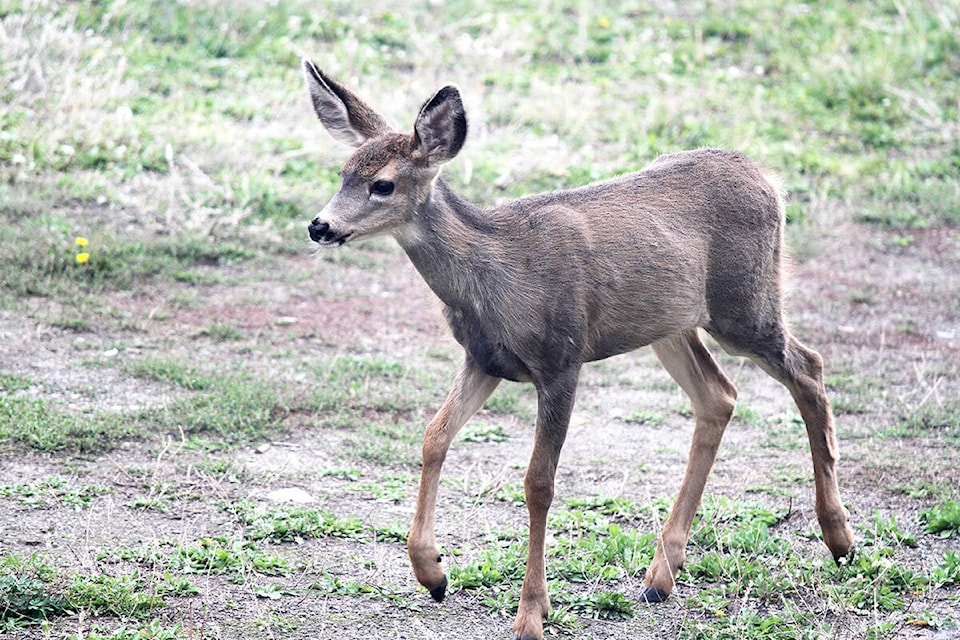By Matteo Cimellaro, Local Journalism Initiative Reporter CANADA’S NATIONAL OBSERVER
Gabe Jules is pulling back on his deer hunts. He has witnessed a drop in both the numbers and health of the deer population in his territory, which has been ravaged by two devastating wildfire seasons in three years.
“We’re seeing some really skinny deer,” Jules, rights, title and wildlife representative for Skeetchestn First Nation, about 60 kilometres west of Kamloops, B.C., said in an interview.
On the land, Jules has seen how severe burns from record-breaking wildfires can affect everything, including winter feed for deer. The catastrophic wildfires in 2021 and 2023 burned shrubs, grasses and lichen — the algae that grow on the barks of trees — leaving deer with little left for winter feeding.
In 2023, the fire season across the province is expected to last until winter. The long, prolonged fire season this year, especially around the Okanagan and Adams Lake near Kamloops, will result in a lot more stressed deer, Jules explained.
Those impacts of the fire seasons have prompted Skeetchestn First Nation to lead a study of the local deer population to test and monitor their stress levels.
The research, supported by Mitacs, an organization that supports partnerships between academia and government, analyzes deer fecal samples with help from the Toronto Zoo to measure cortisol levels, a stress hormone, Shaun Freeman, a wildlife biologist who worked closely with Skeetchestn to conduct the study, told Canada’s National Observer.
The research will be used to inform Skeetchestn on how environmental factors such as wildfires, logging, and development like road density will impact their deer harvesting management to ensure Skeetchestn citizens can still get the protein they need, Freeman explained.
Freeman conducted the study using the 2021 and 2023 wildfire seasons, which were marked by severe fire and prolonged seasons, as opposed to the quieter 2022 wildfire season, to create his dataset.
The research found that in August 2021, the peak of cortisol in deer fecal samples had an average of about 120 nanograms. In comparison, deer in August 2022 had around 50 to 56 nanograms of cortisol.
With a range between baseline and peak cortisol, Skeetchestn can now use the samples to analyze if environmental factors, such as wildfire seasons or resource development, are causing stress in the deer population and putting it at risk.
Sarah Dickson-Hoyle refers to the research approach as “walking on two legs,” a concept defined by a Skeetchestn Elder. The concept refers to Indigenous knowledge and western science as the two legs. However, the Skeetchestn Elder notes that the Indigenous mind is what is compelling those two legs to move forward together.
Walking on two legs flips the script on how a western scientist might typically conduct their research. For example, instead of a researcher creating a project and then seeking a community partner to work with, the First Nation is creating and leading the project for their community purposes. The researcher, instead of serving their own work, can support the First Nation with the tools, methods and resources of western science.
It’s a model that resonates with Dickson-Hoyle, a University of British Columbia fire ecologist and partner of the Secwepemcul̓ecw Restoration Stewardship Society, a Secwepemc-led organization seeking to advance sustainable land management within Secwepemcul’ecw, Secwepemc ancestral territory.
“It’s all guided by Skeetchestn stewardship objectives,” she said.
Dickson-Hoyle has helped identify plants post-wildfires, as well as DNA analysis of what the deer are consuming following different wildfire seasons.
This is a continuation of Dickson-Hoyle’s work following the Elephant Hill wildfire, which devastated the territories in 2017.
In a report published by the Secwepemcul̓ecw Restoration Stewardship Society, an economic assessment found the Elephant Hill fire cost up to $1 billion a year in nature services, including a million a year in carbon sequestration, $101 million in the ability for the land to mitigate flood, and up to $39 million in the provision of ancestral foods like salmon, deer, berries and firewood.
Deer are an important protein source for Secwepemc and hold important cultural values, but they have been continually impacted by cattle ranges, clear-cutting and wildfires, Dickson-Hoyle said.
As a result, land management of First Nation priorities must come before any forms of development, she added.
Measuring deer stress levels is essential to maintaining healthy populations both in a qualitative and quantitative sense.
Stressed deer carry a disease risk, Freeman said. A more stressed population will affect their fitness, leading to a higher risk of disease and predation.
“If you’re gonna harvest an animal, you definitely want a healthy animal,” Freeman added. “You want an animal that’s had its opportunity to reproduce and you want them to be able to produce sufficiently to sustain your harvest.”
The wildfire seasons, alongside other environmental factors like logging and other land management practices, have left Skeetchestn to consider a five- to 10-year reduction in harvest, Jules said.
READ ALSO: Province orders mandatory testing for fatal wildlife disease in southeast B.C.
